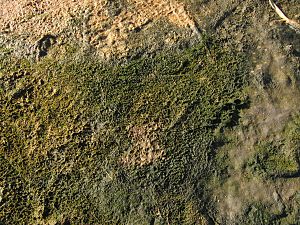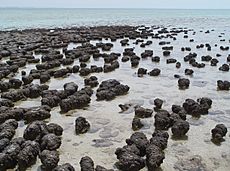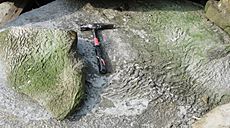Microbial mat facts for kids



A microbial mat is like a thin, multi-layered blanket made of tiny living things called microorganisms. Most of these are bacteria and archaea. These mats were first noticed a long time ago, around 1519. However, scientists only fully understood how important they were much later, in the late 1900s.
Microbial mats usually grow on wet or underwater surfaces. But some can even survive in dry deserts! They can live in many different places, from very cold spots (–40°C) to very hot ones (+120°C). Some microbial mats even live inside animals.
Contents
What Are Microbial Mats Like?
Microbial mats are usually only a few centimeters thick. Even so, they have many different chemical zones inside them. Each layer has microorganisms that can live with or use the chemicals at that level.
When wet, these mats are held together by a slimy substance. This sticky stuff is made by the microorganisms themselves. Some of the tiny living things in the mat form tangled webs. These webs make the mat even tougher.
The most common shapes of microbial mats are flat sheets. They can also form stubby pillars called stromatolites. Sometimes, they even grow into round shapes.
Ancient Life on Earth
Microbial mats are the oldest form of life on Earth that we have good fossil evidence for. These fossils date back 3,500 million years! For a very long time, microbial mats were the most important living things on our planet. They played a huge role in Earth's early ecosystems.
At first, these mats might have gotten their energy and "food" from hydrothermal vents. These are like hot springs on the ocean floor. Then, something amazing happened: photosynthesis developed. This process allowed mats to use sunlight for energy. This meant they didn't have to rely only on hydrothermal vents anymore.
Later, mats developed a type of photosynthesis that produced oxygen. This was a huge step! The main ingredients for this new photosynthesis were carbon dioxide and water.
Creating Our Atmosphere
Because of oxygen-producing photosynthesis, microbial mats started to create the air we breathe today. Free oxygen is a very important part of our atmosphere.
Around the same time, microbial mats might also have been where more complex eukaryote cells first appeared. All multicellular organisms, like plants and animals, are made of these complex cells.
Microbial mats were very common on the shallow seabed. But then, something called the Cambrian substrate revolution happened. During this time, animals in shallow seas started to dig and burrow more. This broke up the mats and let oxygen-rich water get into their deeper layers. This was bad for the microorganisms that couldn't handle oxygen.
Even though this revolution pushed mats out of soft, shallow sea floors, they still thrive today. You can find them in places where animals can't burrow easily. This includes rocky seabeds, shores, very salty lagoons, and even the deep ocean floors.
Modern Uses of Microbial Mats
Microbial mats can use almost anything as nutrients. Because of this, scientists are very interested in using them for industrial purposes. For example, they could be used to help clean water or to clean up pollution.
Images for kids
-
This is a blister-like microbial mat on a ripple-marked surface. It was found on a Cambrian tidal flat at Blackberry Hill, Wisconsin.
See also
 In Spanish: Estera microbiana para niños
In Spanish: Estera microbiana para niños



